Guest Bathroom Dimensions
Bathroom Dimensions
By Meg Escott
This page deals with minimum bathroom dimensions, fixture sizes and clearances required for planning bathroom layouts.
They're based on recommendations for the United States but standards for other modern countries won't be far off. I've included metric conversions and some comments on differences with other countries.
This bathroom dimensions information forms part of the bathroom layouts series.
Just a quick note to keep us all out of trouble
This information is provided in good faith to help you think about your bathroom design. The metric dimensions are approximate. It is your responsibility (or your architect / design professional / contractor team) to make sure your dimensions are in accordance with your local code or regulations.
I recommend this book from the National Kitchen and Bathroom Association for code regulations for the US.
[Disclosure: This is an affiliate link and I stand to earn a small commission if you purchase through this link.]

Minimum Bathroom Dimensions
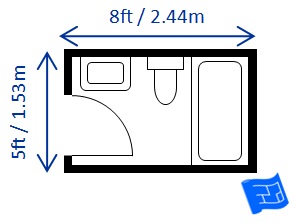
Full bathroom dimensions (bath / shower combination with toilet and sink) 5ft x 8ft (1.5m x 2.4m). This is based on the minimum size of the bath so if you're going for a bigger bath the 5ft side of this bathroom will change slightly.
This is one of the standard layouts for small bathroom floor plans.
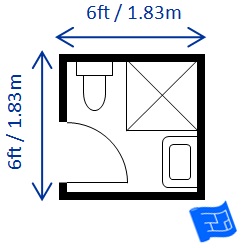
Small bathroom dimensions (shower, toilet and sink) 6ft x 6ft (1.8m x 1.8m)
This is one of the standard layouts for small bathroom floor plans.
| | |
Half bathroom dimensions (toilet and corner sink, pocket door) 5ft x 3ft (1.5m x 0.9m). The minimum you're allowed by code in the US is 5ft x 2.5ft (1.5m x 0.76m). If you're one of my UK readers where there's no regulations (not sure about other places) a smaller arrangement is possible if you use a high wall mounted tank (dotted line) or space saving toilet.
Ceiling heights in bathrooms
If you're trying to sneak a bathroom into that area under the stairs or squeeze one into some left over loft space you need to check the rules about ceiling height. A good rule of thumb is that if you're going to stand (in front of the toilet, in front of the lavatory, in the shower then you need decent ceiling height.
A height of 6ft 8 ins (2.03m) is required in front of all fixture and for a 30 inch (76cm) diameter where the shower head is.
So I guess you can slot the back of the toilet and any portion of the bath that isn't a shower under a sloping ceiling.
Bathroom Fixture Dimensions and Clearances
In this bathroom dimensions section I've included:
- Fixture sizes
- Recommended bathroom dimensions and clearances. These are what you want to make a bathroom feel spacious - perhaps for your master bathroom floor plans.
- Minimum bathroom dimensions and clearances - maybe for using in your small bathroom floor plans or even a Jack and Jill bathroom.
The fixture sizes here will be a useful starting point for planning your bathroom but they come in all sorts of different shapes and sizes so once you've chosen your fixtures use those dimensions in your plans.
Toilet dimensions and clearances (same for bidets)
These measurements also apply to bidets.
Standard toilet fixture size – The standard depth of a toilet seat from hinges to the edge is 16 inches (40.5cm). If you get an elongated model this will be slightly longer – more like 18 inches or 46cm. Then you have the dimensions of the tank arrangements to add to this making the total depth from about 26 inches to 29 inches (66cm – 74cm). In Europe there are space saving options available that are smaller than this because there is no minimum size required for a toilet room.
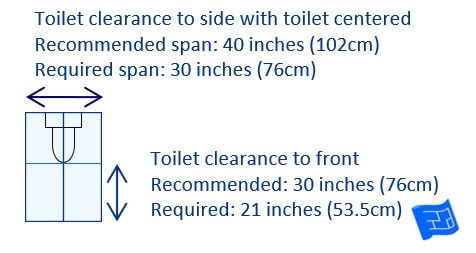
Recommended toilet clearance - 20 inches (51cm) is recommended from the center line of the toilet seat to the nearest wall or obstruction. This means a span of 40 inches (102cm) is recommended to accommodate a toilet. The recommended clearance in front of the toilet is 30 inches (76cm).
Minimum code toilet clearance - The minimum distance required from the toilet center line to the nearest obstruction is 15 inches (38cm). The minimum distance required from the edge of the toilet to the wall is 4 inches (10cm). This means the minimum span required to accommodate a toilet is 30 inches (76cm). A minimum of 21 inches (53cm) is required is required in front of a toilet or bidet.
Toilet paper holder location – the suggested position is 8-12 inches (20 - 30cm) from the front of the toilet seat to the center line of the toilet paper holder, and a height of 26 - 30 inches (66 - 76cm).
Recommended toilet clearanc
– 20 inches (51cm) is recommended from the center line of the toilet seat to the nearest wall or obstruction. This means a span of 40 inches (102cm) is recommended to accommodate a toilet. The recommended clearance in front of the toilet is 30 inches (76cm).
Minimum code toilet clearance - The minimum distance required from the toilet center line to the nearest obstruction is 15 inches (38cm). The minimum distance required from the edge of the toilet to the wall is 4 inches (10cm). This means the minimum span required to accommodate a toilet is 30 inches (76cm). A minimum of 21 inches (53cm) is required is required in front of a toilet or bidet.
Toilet paper holder location – the suggested position is 8-12 inches (20 - 30cm) from the front of the toilet seat to the center line of the toilet paper holder, and a height of 26 - 30 inches (66 - 76cm).
Bathtub dimensions and clearances
Standard bathtub dimensions - The smallest standard bath is 5ft x 2 ½ feet (153cm x 76cm).
Whirlpool tubs with dimensions of 5ft x 2 3/4ft or 153cm by 81cm are available.
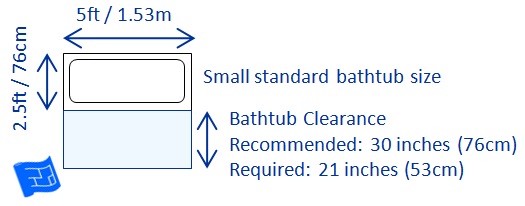
Recommended bathtub clearance - 30 inches (76cm) should be left as clear space along the edge of the bathtub.
Minimum bathtub clearance - A minimum of 21 inches (53cm) must be left as clear space along the edge of the bathtub.
Bathtub controls location - You need to be able to reach the tub controls from both inside and outside the tub. They should be placed between the rim of the bathtub and 33 inches (84cm) above the floor.
Sink, washbasin, lavatory or vanity dimensions and clearances
What a lot of words that mean the same thing in various parts of the English speaking world! I'm going to use the words washbasin and vanity.
These come in lots of different sizes and a corner vanity, or a lavatory that is wide but not very deep can solve all sorts of design challenges in bathrooms.
Standard vanity cabinet measurements - 2ft (60cm) deep.
Standard washbasin height - Standard vanity height or washbasin height starts at about 30 inches (76cm) high and goes up to say 43 inches (119cm). At the lower heights most people will have to stoop to use the sink. Try out different heights in the bathroom centers to find the right height for you. Just as a comparison standard kitchen worktops are at 36 inches (92cm).
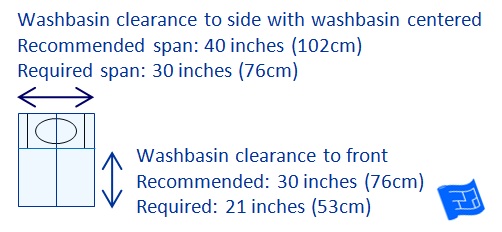
Recommended single washbasin clearance - 20 inches (51cm) is recommended from the center line of the washbasin to the nearest wall or obstruction. So a span of 40 inches (102cm) is recommended for a single washbasin.
30 inches (76cm) is recommended as clear space in front of the washbasin.
Minimum single washbasin clearance - A minimum distance of 15 inches (38cm) is required from the center line of the washbasin to the nearest wall or obstruction. This means a span of 30 inches (76cm) is required for a single washbasin. A minimum of 4 inches (10cm) is required from the edge of a washbasin to the nearest wall or obstruction.
A minimum of 21 inches (53cm) is required in front of the washbasin.
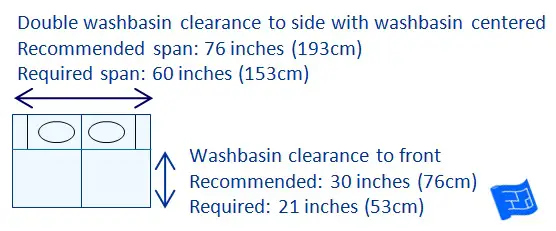
Recommended double washbasin clearance - 36 inches (92cm) is recommended between the center lines of two washbasins. This means a span of 76 inches (193cm) is recommended for a double washbasin.
30 inches (76cm) is recommended as clear space in front of the washbasin.
Minimum double washbasin clearance - A minimum distance of 30 inches (76cm) is required between the center lines of two washbasins. So you need a span of 60 inches (153cm) for a double washbasin. A minimum of 4 inches (10cm) is required between the edges of hanging or free standing washbasin.
A minimum of 21 inches (53cm) is required in front of the washbasin.
Shower Dimensions and Clearances
Standard Shower dimensions - The smallest showers available are 32 x 32 inches (81 x 81 cm). This makes for stand up straight washing – if you can fit in a rectangular shower of 36 inches by 48 inches or larger you'll be more comfortable and your elbows will thank you.
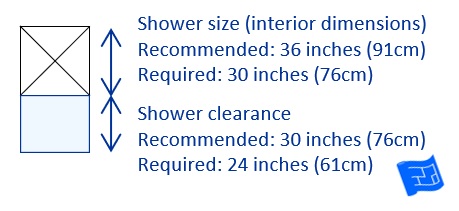
Recommended shower dimensions and clearance - A shower size of 36 x 36 inches (91 x 91cm) is recommended.
30 inches (76cm) of clear space is recommended in front of the entry to the shower.
Minimum shower dimensions and clearance. - a minimum shower size of 30 x 30 inches (66 x 66cm) is required.
A minimum of 24 inches (61cm) is required in front of the entry to the shower
Shower doors - hinged shower doors must open outwards
Electrical and lighting Clearances
Light switch clearance - A minimum clearance of 5ft is required between a water source and a light switch.
Light fixtures - All the light fixtures that you choose for the bath and shower spaces need to be suitable for a wet environment.
A hanging fixture must be at least 8ft (2.44m) higher and 3ft (91cm) away from the bath rim
Other sockets – the regulations in each country vary with respect to power in the bathroom. It's all to do with the danger of electrocution when water electricity mix.
All circuits must be protected by GFCI (Ground Fault Circuit Interrupters).
Bathroom door size
A standard bathroom door is 32 inches (81cm). If you're working with a really small space you could bring the door width down to 28 inches or 71cm, even down to 24 inches or 61cm as an absolute minimum (note - small doors are should only be used for bathrooms, closets and utility rooms). Don't worry – you'll still be able to get the bath through the door.
More bathroom design for you...
More room design for you...
Source: https://www.houseplanshelper.com/bathroom-dimensions.html







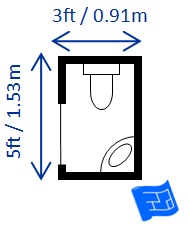
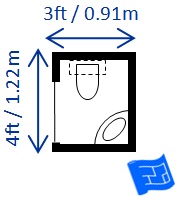


Tidak ada komentar:
Posting Komentar